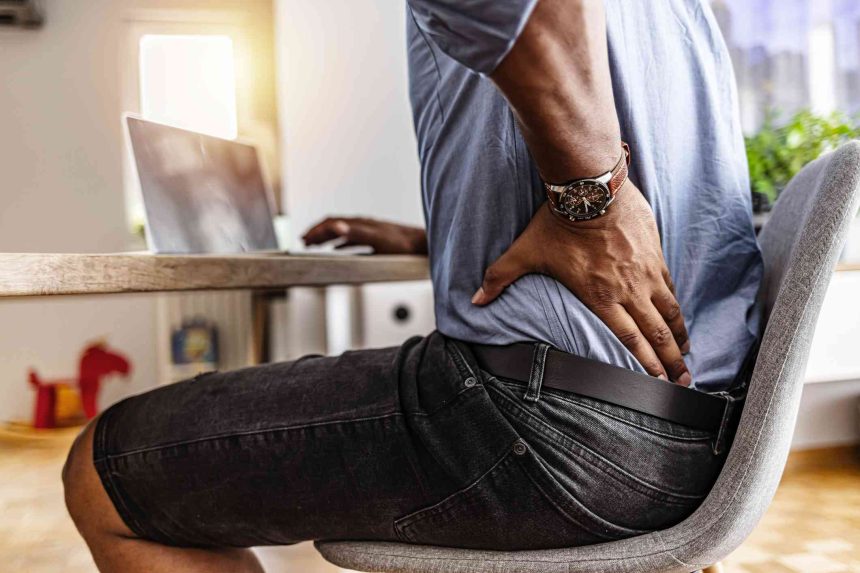Your latissimus dorsi (your “lats”) is a broad, flat, triangle-shaped muscle that spans your middle and lower back and extends to the front of your humerus (upper arm bone). It plays a role in many arm movements and supports respiratory muscles to help with breathing.
Traumatic or overuse injuries to your lats can cause pain and discomfort that affects your mobility. Pain in this muscle sometimes develops due to underlying structural abnormalities in the spine.
Whatever the cause, effective treatments can help restore the mobility and function of your arms and back and relieve pain in your latissimus dorsi.
Your lats are the widest and largest muscles in your back, so you may feel latissimus dorsi pain in one or more places, including your:
- Lower back or mid-back, where the latissimus dorsi attaches to the spine and ribs
- Sides of the torso, where the muscle wraps around your rib cage
- Upper arms, with pain that may radiate down your arms and to your fingers
Pain in the lat muscle can affect upper body strength and function, causing trouble performing tasks that involve lifting, reaching, or rotating your arm or torso. Because the latissimus dorsi muscle supports respiration (breathing) muscles, you may feel pain when taking a deep breath, coughing, or sneezing.
Latissimus dorsi pain can develop due to injuries to the muscle or surrounding structures, structural abnormalities, or underlying conditions. The location and severity of pain in your lat muscle can help determine the possible cause.
Muscle Strain
Muscle strain, or pulled muscle, is a common cause of latissimus dorsi pain. It occurs when the muscle is overstretched or overused, and part of the muscle tears.
A latissimus dorsi strain may develop suddenly after intense upper body movements, in which case you may feel a “popping” sensation at the time of injury. Lat muscle strain is often an overuse injury that develops in people who perform repetitive upper body movements, like baseball pitchers.
Symptoms of latissimus dorsi muscle strain include:
- Aching or burning pain
- Bruised skin over the affected area
- Swelling
- Limited range of motion, stiffness, and difficulty engaging in movements like pulling and lifting
Poor Posture
Poor posture can stress the latissimus dorsi muscle and cause pain. Slouching, rounding your shoulders, or a forward head posture—when your head juts forward and is out of alignment with your spine—can stress back muscles, including your lat muscles.
This misalignment causes the muscle to become fatigued, inflamed, and tight over time. As the muscle fatigues, you may feel pain in your lower back or under or around your shoulder blades.
Prolonged sitting, spending a lot of time in front of a computer, and poor ergonomic setups are common causes of poor posture. Symptoms of poor posture affecting the latissimus dorsi include:
- Dull ache in the lower back, torso, or near the shoulder blades
- Stiffness
- Muscle tenderness and soreness
- Fatigue
- Headaches
- Limited range of motion in your upper or lower back
Thoracodorsal Nerve Injury
The thoracodorsal nerve supplies motor function (movement) to the latissimus dorsi muscle. Injury or damage to this nerve can cause pain, weakness, and muscle paralysis. Injury to this nerve is rare but can occur as a complication of surgery in the chest or shoulder area, such as breast reconstruction or lymph node dissection (removal) in the armpit or chest area.
Symptoms of thoracodorsal nerve injury include weakness or difficulty performing movements such as pulling objects, extending your arm above or behind your body, or standing up from sitting in a chair. This may also include shoulder weakness.
Tendon Rupture
A latissimus dorsi tendon rupture is a rare injury that can cause severe pain. It occurs when the tendon connecting the lat muscle to the bone partially or wholly tears or ruptures. Athletes involved in sports requiring forceful overhead movements have a higher risk of this injury.
Symptoms can include:
- Sudden, severe pain in your shoulder or upper arm
- Arm weakness
- A popping or tearing sensation at the time of injury
- Swelling in the affected area
- A visible lump or mass on your upper back
- Difficulty moving the affected arm or shoulder
Spinal Problems
Structural problems with the spine can cause latissimus dorsi pain. Structural issues involve physical changes in the spine, such as:
- Scoliosis (abnormal S- or C-shaped curvature of the spine)
- Kyphosis (rounding forward of the upper back)
- Spinal stenosis (narrowing of the spinal canal)
Spinal problems can affect the body’s balance and weight distribution, putting uneven pressure and strain on the lat muscle and leading to pain and fatigue. For example, with scoliosis, the body’s muscles can become imbalanced, causing some muscles to become overly tight or weak while others overcompensate. This can lead to muscle strain and pain.
Symptoms associated with latissimus dorsi pain from spinal issues can include:
- Dull, aching pain
- Muscle spasms
- Muscle tightness and stiffness
- Reduced range of motion
- Worsening pain during movements that involve the upper body, such as reaching overhead
Myofascial Pain Syndrome (MPS)
Myofascial pain syndrome (MPS) is a chronic pain disorder that can cause latissimus dorsi pain when trigger points develop in the muscle. Trigger points are tight, sensitive areas within a muscle that can spread pain to other body parts.
When these trigger points form in the latissimus dorsi, muscle tension can cause discomfort in your upper or lower back, torso, and sides and referred pain in the arms and neck.
MPS may develop after injury to the latissimus dorsi, though it often develops with no previous injury. Symptoms of MPS include:
- Persistent muscle pain, tightness, and stiffness
- Taut bands of muscle, or “knots,” you can feel under the skin
- Tenderness at the trigger points
- Limited range of motion
- Worsening pain during physical activity
To diagnose the cause of latissimus dorsi pain, your healthcare provider will review your medical history and perform a physical examination. They will ask about your symptoms, including when you first developed lat muscle pain, how long it lasts, what activities worsen or improve the pain, and whether you had any recent injuries or accidents.
During the physical examination, your healthcare provider will assess your posture and movement patterns. They may ask you to make specific movements to determine your range of motion, muscle strength, and tenderness in the latissimus dorsi.
Diagnostic tests are often necessary to help pinpoint the cause of latissimus dorsi pain. Your healthcare provider may order imaging tests like:
- X-rays: This test allows the visualization of the bones and joints in the spine and shoulder.
- Magnetic resonance imaging (MRI): An MRI scan provides detailed pictures of the latissimus dorsi muscle and other soft tissues in your back to help identify injuries, such as a tendon rupture (tear).
- Electromyography (EMG): An EMG test measures the electrical activity of muscles while they are moving and at rest, helping to diagnose nerve-related issues and injuries.
Treatment for latissimus dorsi pain depends on the underlying cause. You may have several options:
At-Home Treatments
Your healthcare provider may initially recommend at-home treatments to rest the muscle and promote recovery. These may include:
- Rest: Resting the muscle by avoiding activities that aggravate the muscle injury and worsen the pain gives the muscle time to heal.
- Ice and heat therapy: Applying ice packs to the painful area can help reduce inflammation and pain. Heat packs or a heating pad can help relax and loosen tight muscles.
- Over-the-counter pain (OTC) medications: OTC medications, such as Tylenol (acetaminophen), Advil (ibuprofen), and Aleve (naproxen), can help provide temporary pain relief.
- Stretching exercises: Gentle stretches that target the latissimus dorsi may improve flexibility and increase blood flow to the muscle, promoting healing.
- Good posture: Correcting poor posture and making ergonomic adjustments to your workstation and daily activities can help prevent further strain on the muscle.
Medications
Your healthcare provider may prescribe medications to reduce inflammation and pain and promote healing while you recover. These may include:
- Nonsteroidal anti-inflammatory drugs (NSAIDs)
- Corticosteroid injections
- Platelet-rich plasma (PRP) injections
- Muscle relaxants
Physical Therapy
Physical therapy is a standard treatment for latissimus dorsi pain that develops from injuries like muscle strains or tendon ruptures. A physical therapist will create a personalized rehabilitation plan that includes exercises to strengthen your latissimus dorsi and surrounding muscles, improve flexibility, and correct poor posture.
Some physical therapists use massage, transcutaneous electrical stimulation (TENS), and other techniques to soothe painful muscles while you recover.
Surgery
Your healthcare provider may recommend surgery when more conservative treatments are ineffective or when you have a severe injury or structural damage, such as tendon rupture or scoliosis. Surgery may involve repairing a damaged muscle or tendon or reconstructing and correcting a spinal abnormality like scoliosis.
While some causes of latissimus dorsi pain may resolve with self-care measures like rest and ice therapy, it’s important to seek medical attention if you have pain that lasts three days or longer. You should also see a healthcare provider if you experience any of the following symptoms:
- Weakness or numbness in your arm
- Difficulty breathing
- Fever
- Swelling or redness in the affected area
- Worsening pain despite self-care measures
- Pain that develops after an accident or fall
Latissimus dorsi pain has several possible causes, most involving injury to the muscle or its supporting structures. As one of the body’s largest muscles, pain in the lats can affect your ability to engage in daily activities.
Most causes of latissimus dorsi pain resolve with self-care strategies like ice, heat therapy, and rest. If your pain is persistent or severe, talk to your healthcare provider about alternative treatment approaches, such as medications or physical therapy.






